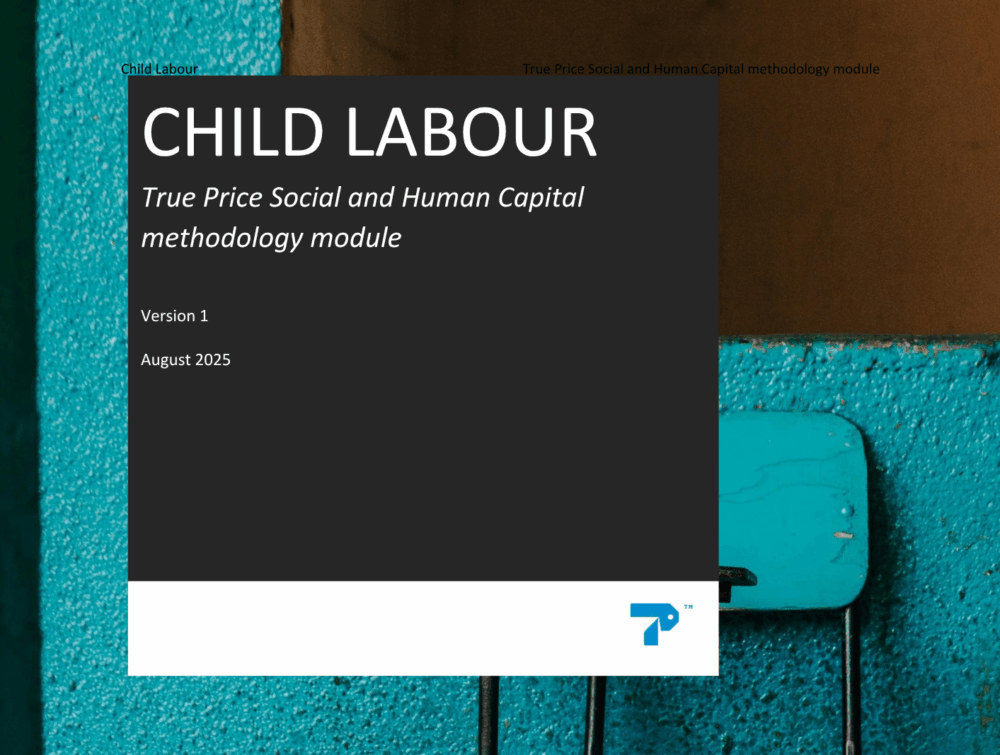A recent UNICEF and ILO report shows that 1 in 10 children worldwide are still affected by child labour, a sobering reminder of the hidden human toll embedded in global value chains. The good news is that there is progress, and child labour is steadily decreasing. However, the report also makes it clear that to end it within the next five years and meet the Sustainable Development Goal 8.7 (which includes eliminating all forms of it by 2030), the current rate of progress would need to be 11 times faster than what we are seeing today.
To help the global effort to eliminate child labour, True Price has released a new methodology module to estimate its social cost for true cost accounting and true pricing:
Child Labour – Social and Human Capital methodology module
Child labour remains largely invisible in market transactions, and we are largely unaware of its presence in the products we buy, as consumers, professionals and organisations. This new True Price module offers a clear approach for measuring the social cost of child labour and how significant this hidden cost is in comparison to product prices.
While no monetary value will ever capture the harm caused to victims of child labour, this approach aims to make a part of these hidden social costs visible. And it does so through a rights-based approach that shines a light on existing, unmet responsibilities in the global market, and reinforces the duty to prevent and remediate rights violations.
What’s in the module?
The document provides a step-by-step method for assessing the external cost of child labour in products and value chains. It includes:
- Definitions of child labour used in the methodology, based on international standards.
- Background and rationale of why we think that it is meaningful to calculate the true price of child labour, how this method can be used, and how it relates to other labour rights impacts.
- Impact framework describing the underlying logic of child labour as a social cost, including key drivers, negative effects on children’s lives, and a classification system for types of child labour of different severity.
- Quantification guidance for estimating child labour in value chains, including footprint indicators and potential data sources.
- Monetisation approach for valuing the impact based on remediation cost, covering compensation, retribution, and prevention of re-occurrence costs, as well as monetisation factors in EUR/hour of hazardous and non-hazardous child labour.
- Limitations and research needs, outlining current methodological constraints, data gaps, and areas for future development to improve accuracy and applicability.
Broader context and how to use it
This module is part of a growing set of methodology documents developed by True Price to support consistent, transparent, and credible true pricing assessments. These publications provide guidance to businesses, researchers, and policymakers working to embed social sustainability into procurement, pricing, and decision-making processes.
It is designed to be used in combination with the True Pricing Assessment Method, which outlines the steps for calculating the true price of products by capturing both social and environmental externalities, and the other impact modules released in the Social and Human Capital and Natural Capital series.
Contact us & get involved
If you would like to explore implementation in your organisation, or if you have any questions about this publication, send us an email at info@trueprice.org.
This methodology is the fruit of more than ten years of experience assessing social and environmental costs of value chains with a rights-based perspective. But we don’t see it as a point of arrival. It is a “version 1”, the starting point for an urgent global conversation in the accounting and valuation world about how to incorporate human rights in our accounting standards, and how to contribute to eliminating child labour from value chains. Reach out to us and let’s keep the conversation going.
